If you’re struggling to build strength and tone in your chest muscles, you may have already tried classic chest exercises like push-ups and bench press. However, you may not have heard of a simple yet effective exercise called resistance band flys. Don’t worry, you’re not alone! Many people struggle to find the best exercises to target their chest, and that’s because the chest muscles can be tricky to hit from all angles. But don’t lose hope! In this post, we’ll show you how to perform resistance band flys and how they can help you develop stronger and more defined chest muscles.
Resistance Band Flys Summary
- Primary Muscles: Pectoralis Major – Sternal
- Secondary Muscles: Latissimus Dorsi, Levator Scapulae, Pectoralis Major – Clavicular, Pectoralis Minor, and Rhomboids
- Equipment: Resistance band and door anchor
- Mechanics Type: Isolation
- Force: Push
- Utility: Auxiliary
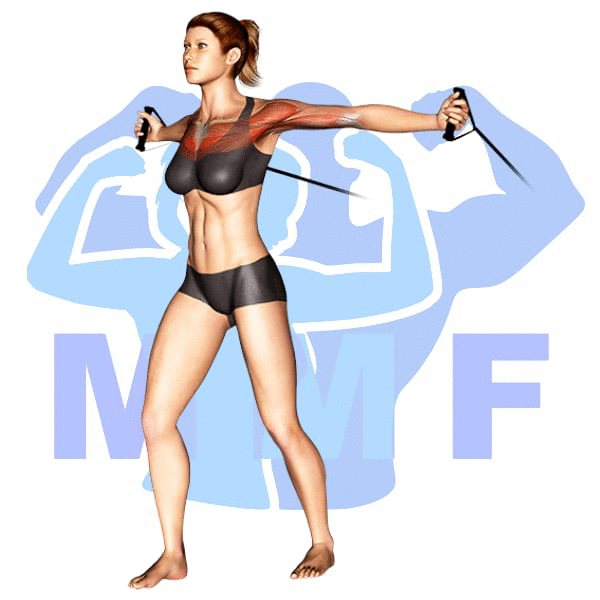
Resistance Band Flys Instructions
- Attach the resistance bands to your anchor point to a height that is just below your armpits.
- Grab the handles in both hands while facing away from the anchor point.
- Step out with you arms straight out to your sides until the bands are tight.
- Next, Bring the band handles together in a hugging motion while maintaining your elbows in a fixed position.
- Your only hinge should be at your shoulders, and you should be utilizing your chest to pull the handles together.
- To complete the rep allow your arms to return to your side while stretching out your chest
- Repeat your flys for 8-12 reps.
Video Tutorial
Resistance Band Flys Muscles
Target (Agonist)
- Pectoralis Major, Sternal
Synergists
- Latissimus Dorsi
- Levator Scapulae
- Pectoralis Major – Clavicular
- Pectoralis Minor
- Rhomboids
Dynamic Stabilizers
- None
Stabilizers
- Biceps Brachii
- Brachialis
- Obliques
- Rectus Abdominis
- Triceps Brachii
- Wrist Flexors
Antagonist Stabilizers

Benefits of Resistance Band Flys
Resistance Band Flys are an effective exercise for strengthening the pectoralis major – sternal muscle. This exercise requires you to use your body weight and a resistance band to move your arms apart and back together. By doing this, it increases the resistance for the pectoral muscles and strengthens them. Resistance Band Flys also help improve shoulder mobility and stability, which can help prevent shoulder injuries. Additionally, this exercise is great for building strength in the chest and upper body without straining your joints.
Tips for Performing Resistance Band Flys
If you’d like to attain the right returns, adhere to these essential tips. Furthermore, if you would like to minimize the chance of injuries, abide by these tips.
- Make certain The Bands Are Strained. Before you begin the workout make sure the resistance bands are not hanging.
- Do The Correct Amount Of Sets Along With Rest. Your target, in the beginning, ought to be to do 3 sets to near fatigue. However, you can increase to 5 sets. If your muscle tissue isn’t fatigued at the ending of 3 – 5, something needs to change. Initally, you can increase the resistance to make each rep harder. Next, you can decrease the rest time in between your sets.
- Make Use Of A Mirror To Watch Your Technique. You may think you are a little vain looking in a mirror while you are exercising, but you are not admiring yourself, you are making certain your technique is effective.
Benefits and Tips Video
Frequent Mistakes To Avoid
You have to keep from making these regularly occurring mistakes to ensure solid form and reaching your goals. Llikewise
- Don’t have unmatched tension one each band, because you will use both sides with an imbalance.
- Don’t Cheat. Most of the time, cheating is utilizing momentum rather than the strength of your main muscle. Sometimes, a little bit cheating on your last rep can be great to overload your muscle, however not for more than a few reps.
Find More Resistance Band Exercises Here
Variations and Complementary Exercises
When looking to mix up your resistance band flys, there are plenty of variations, complementary, and alternative exercises that you can include in your workout routine. These exercises work similar muscles as the exercise Resistance Band Flys, but offer a new challenge to keep your muscles from plateauing. Below are a few exercises to consider.
Resistance Band Chest Press

The Resistance Band Chest Press is a great complementary exercise to Resistance Band Flys. It works the same muscles as the flys but in a different way. The chest press is a pushing exercise, which works the pectoral muscles and the anterior deltoids, while the flys are a pulling exercise that work the same muscles. Resistance Band Chest Presses can also be used as an alternative to flys for those who may not have access to a pull-up bar or other equipment needed to perform the flys. The resistance band chest press is a great way to increase strength and muscle development in the chest and shoulder area.
Resistance Band Push Ups
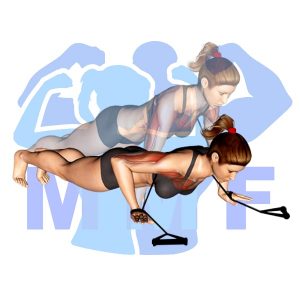
Resistance Band Push Ups are a complementary or alternative exercise to Resistance Band Flys, providing an added challenge to the chest muscles and arms. This exercise requires you to lie on the floor or an exercise mat, holding the resistance band in each hand with the handles close together. From here, you perform a regular push up while keeping tension on the band. The added resistance from the band will make it more difficult to complete the push up and will work your chest, shoulders, and triceps even more than a regular push up.
Resistance Band Low Chest Flys

Resistance Band Low Chest Flys is a great complementary or alternative exercise to Resistance Band Flys. It helps to target the lower chest muscles and also works the upper chest and shoulder muscles. This exercise can be performed while lying down on a mat, or while standing with feet slightly wider than shoulder-width apart. To perform this exercise, one should hold a resistance band in each hand, and then slowly bring the arms out to the side, pushing against the band. The arms should be kept straight throughout the exercise and returned to the starting position when finished. This exercise is a great way to help build strength and muscle in the chest and shoulders, while still providing an effective workout for the core muscles as well.
Check Out These Top Resistance Band Exercises
Resistance Band High Chest Flys
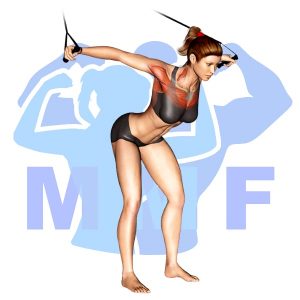
Resistance Band High Chest Flys are a great alternative or complementary exercise to Resistance Band Flys. This exercise is performed by standing with your feet shoulder width apart and holding the band in both hands with your arms straight out in front of you at shoulder level. You then move your hands out to the sides and up above your head, while keeping your elbows slightly bent and your arms straight. This exercise targets the chest muscles and helps to build strength and size. It is a great way to add variety to your workout routine and is an effective way to target the same muscle groups as Resistance Band Flys.
Close Grip Push Up

Close Grip Push Up is an excellent complementary or alternative exercise to Resistance Band Flys. It works the same muscles, but puts the body in a different position. To perform a Close Grip Push Up, start in a push up position with your hands slightly closer than shoulder-width apart. Lower your chest towards the floor, keeping your elbows close to your body and your core engaged throughout the exercise. Push back up to the starting position and repeat. This exercise is great for building strength and endurance in your chest, triceps, and shoulders.
Lever Pec Deck Fly (Machine)
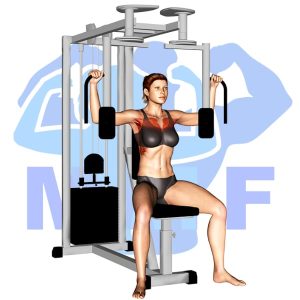
The Lever Pec Deck Fly machine is a great alternative or complementary exercise to Resistance Band Flys. It is a seated machine exercise that helps isolate and strengthen the chest muscles. The range of motion can be adjusted to fit your individual needs, making this an effective exercise for both novice and experienced gym-goers alike. The Lever Pec Deck Fly also allows you to use heavier weights than you would with a Resistance Band Fly, which can help you build muscle faster and more efficiently. With its adjustable range of motion and heavier weights, the Lever Pec Deck Fly is a great tool for those looking to target their chest muscles without having to use bands.
Find More Chest Exercises Here
Opposing Complementary Exercises
Using opposing muscle groups can help to prevent muscular imbalances and improve overall strength. The following exercises are designed to work the opposing muscles of the Resistance Band Flys, allowing you to build a balanced and strong body.
Seated Underhand Cable Row

The Seated Underhand Cable Row is a great complement to Resistance Band Flys, as it works the opposite muscle group. This exercise requires you to sit on a bench and pull the cable towards your body with your elbows tucked in. You should use an overhand grip for this exercise, as it will target the back muscles more effectively. As Resistance Band Flys work the chest muscles, the Seated Underhand Cable Row works the back muscles, providing a balanced workout for both upper body muscle groups.
Inverted Row

The Inverted Row is an excellent complement to Resistance Band Flys. It is a bodyweight exercise that targets the back muscles, while Resistance Band Flys target the chest muscles. The Inverted Row works to strengthen the lats, rhomboids, and traps, while Resistance Band Flys focus on building chest strength. By performing both exercises in a workout, you can build a balanced upper body with both pulling and pushing movements. Moreover, the Inverted Row helps create a stronger base for other back exercises such as pull-ups and rows.
Reverse Grip Bent Over Dumbbell Row
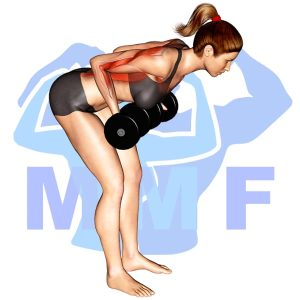
Reverse Grip Bent Over Dumbbell Rows are an excellent complementary exercise to Resistance Band Flys as they target opposing muscle groups. Reverse Grip Bent Over Dumbbell Rows work the back muscles, including the latissimus dorsi, rhomboids, and trapezius, while Resistance Band Flys target the chest muscles, such as the pectoralis major and minor. Doing both of these exercises in conjunction will not only help to strengthen both muscle groups, but will also help to create a balanced physique.
Get Fit with Resistance Band Flys
Resistance band flys are an effective way to add variety to your workouts and target your chest muscles. Using resistance bands can help to engage muscles that may not be as activated during traditional weightlifting exercises. Incorporating resistance band flys into your routine can help to increase muscle activation in your chest, leading to improved muscle tone and definition. Additionally, resistance band flys can be a great alternative to free weights for those who may not have access to a gym or weight equipment. With proper form and technique, resistance band flys can be a valuable addition to any fitness routine.
References: Wikipedia | ExRx.net | PubMed.gov | Comprehensive List of Chest Resistance Band Exercises

